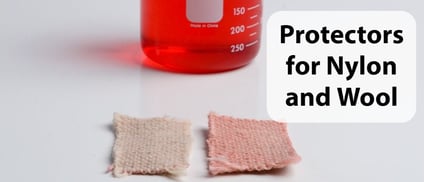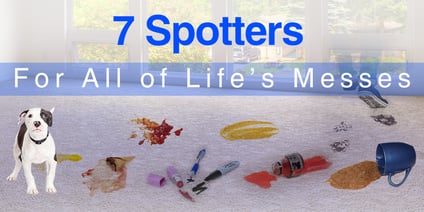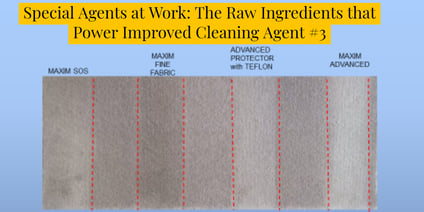Do You Know Your Protector Chemistry?
Are you protecting your customers’ valuable surfaces, or just wasting time and money? Read our guide to select the right carpet protector for the job.
Knowledge is the sign of a true professional carpet cleaner. Anyone with a strong back can push a wand, but a pro knows the difference between an oxidizer and a reducer. Our customers spend a significant amount of money on their carpet, both on the initial purchase, and on maintenance costs. Their expectation is that we as the “professionals” know the carpet fiber type and what equipment and chemicals are best suited for it.
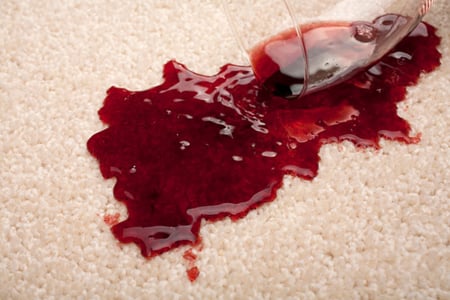
PROTECTORS ARE AN IMPORTANT PART OF THE CLEANING PROCESS
Protectors prevent permanent stains, reduce resoiling, reduce abrasive damage to the carpet fibers and make your cleaning job easier on your next visit.
WHAT ARE THE TYPES OF PROTECTORS?
There are 3 main types: repellents, dye blockers and hybrids that contain both.
REPELLENTS
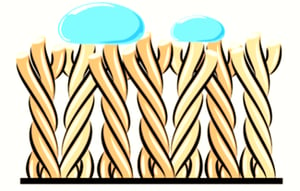 Repellents include fluorochemical and silicone protectors. These protectors lower the surface energy of the fiber and prevent oil and water from penetrating into the fiber and staining it. A familiar example of this is your cooking pan coated with Teflon™. The Teflon layer prevents your pancake from sticking to the pan and allows you to impressively flip it over in the pan without making a gooey mess.
Repellents include fluorochemical and silicone protectors. These protectors lower the surface energy of the fiber and prevent oil and water from penetrating into the fiber and staining it. A familiar example of this is your cooking pan coated with Teflon™. The Teflon layer prevents your pancake from sticking to the pan and allows you to impressively flip it over in the pan without making a gooey mess.
Repellents' strengths are that they coat the fiber and protect it from abrasion, like sand; they also repel water and oil well, and make it easier to remove oils from oleophilic (oil-loving) fibers like triexta. If you’ve ever been tasked with cleaning an oily traffic lane on polyester, triexta, or olefin that hasn’t been protected—you’ll appreciate this.
Repellents also have their weaknesses. While they lower the surface energy and prevent penetration of water and oil-based substances, this can be overcome with heat or pressure. If steaming hot coffee is spilled from waist height, it will penetrate the protection and possibly stain the carpet, especially if it’s not cleaned up immediately. NOTE: this is only true on nylon and wool carpet as they have dye sites and the others don’t.
Product Example: Advanced Protector with Teflon. This protector contains a fluoroprotector to provide superb water and oil repellency.
DYE BLOCKERS
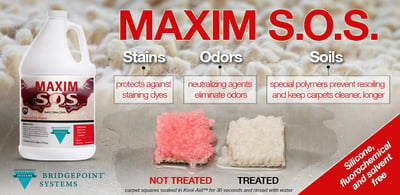
Dye blockers don’t repel water or oil. Instead, they fill up the dye sites on fibers like nylon and wool that have dye sites. These fibers have sites with positive charges that can bind to negatively charged dyeing agents found in kids' drinks, red wine, and mustard. Dye blockers work by filling up these available dye sites with an invisible anionic polymer.
When red wine is spilled on a carpet protected with a dye blocker the liquid won't bead on the carpet. Instead it falls through. Blotting with a towel will remove the red wine and the protected carpet won't stain.
Product Example: Maxim S.O.S. This video shows how protectors using dye blocker technology, like Maxim S.O.S., work.
HYBRIDS

Hybrids combine repellents and dye blockers into one product. This makes applying protector convenient because you don’t have to worry about the fiber type as much because whether the fiber has dye sites or not, the carpet will get protection one way or the other. This also means you can carry fewer protectors on your van.
The disadvantage to this is that like everything in life, the jack-of-all-trades is never the best at a single thing. There is only so much raw material you can put in a formula, so even if the formula contained 100% active ingredients, 50% of that dye blockers and 50% repellents, this product wouldn't be as good of a repellent as a product with 100% repellent. Also, due to chemical interactions, some ingredients are incompatible; e.g., an anionic protector shouldn't be mixed with a cationic protector since the opposite charges create problems with the formula.
Product Example: Maxim Advanced. Because Maxim Advanced works well on carpet with dye sites, and carpet without dye sites, is easy to apply, and is solvent-free, it's the go-to choice for most cleaners and the best-selling protector in the industry.
I like tables, as they make it easier to digest lots of information, so I've created the table below. One thing you'll notice is that Maxim S.O.S. doesn't seem to offer as much protection as the others.
So... why would you select that as your protector instead of something like Maxim Advanced? While it won't provide the repellency or abrasion resistance of Maxim Advanced, it does have some unique advantages. First, it will provide superior acid dye resistance for nylon and wool carpets due to the increase in acid-dye blockers. Also, it was designed to be our greenest and most pleasing protector for sensitive homeowners. It's fluorochemical-free, solvent-free, has an odor neutralizer, pleasant scent, and resists re-soiling. Solvent protectors tend to stink up a house when used.
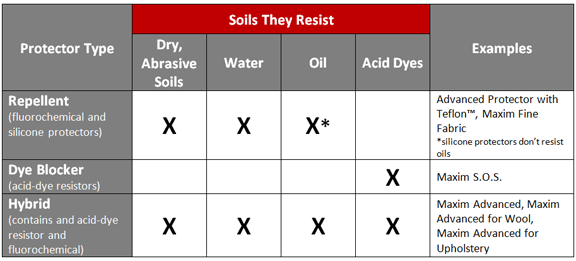
WHY ARE THERE DIFFERENT TYPES OF PROTECTORS?
The main reason is that there are different types of fiber. The fibers you’ll encounter, and need to protect from staining and abrasion, have different characteristics that require different methods for protecting them.
There are three primary categories that you’ll need to protect:
- CARPET WITH DYE SITES
- Includes nylon and wool
- CARPET WITHOUT DYE SITES
- Includes polyester, olefin, triexta
- UPHOLSTERY
- Fibers that are water-sensitive
- Fibers that are water-safe
CARPET WITH DYE SITES
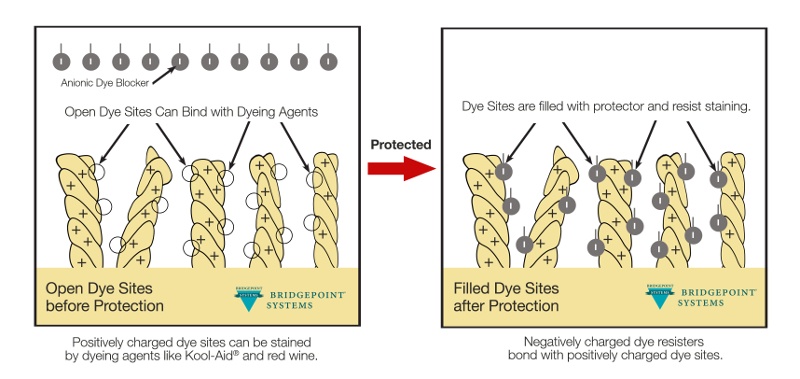
Nylon and wool have “dye sites” along the fiber that allow it to be dyed. When your carpet is manufactured, the carpet mills use these dye sites to add color to your carpet. Most carpet is also protected with an anionic dye blocker at the mills to prevent any further dyeing. That's because these dye sites aren't selective, they'll also accept the dyes in your kid's grape juice−adding a nice purple spot to your white carpet!
When selecting a protector for nylon or wool carpet, the most important performance feature is stain resistance provided by an anionic dye blocker.
CARPET WITHOUT DYE SITES

For years, nylon and wool were the dominant carpet fibers, and many customers valued carpet protection, as demonstrated by the huge popularity of Stainmaster™ fibers. Recently; however, polyester, olefin, and triexta have started to take the place of nylon as the dominant fiber for residential carpet.
Polyester, olefin, and triexta don't have dye sites. They have their color “built-in” and can’t be dyed. This is a good thing if your kid spills his Kool-Aid® on your carpet. Since there are no dye sites, you can just wipe it up without leaving a bright red spot behind.
Nothing is bulletproof though… These fibers' Achilles heel is oil. They love it. You’ll hear them called oleophilic (oil-loving) fibers, because they suck oils up and don’t easily release them. These types of carpets get very noticeable traffic lane patterns that are difficult to clean. Aggressive chemistry and high heat are often required to eliminate the grungy look these fibers get over time.
Because there aren't dye sites, there is no need to use an anionic dye blocker, it wouldn't bind to the carpet fiber and you'd be wasting time and money. Use a fluoroprotector like Advanced Protector with Teflon™ instead. These protectors will repel oil and water and limit the amount of oily soils the carpet soaks up - it’ll keep the carpet looking newer, longer, and make your cleaning a year later MUCH easier.
When selecting a protector for polyester, triexta, and olefin the most important feature is oil resistance provided by quality fluoroprotectors.
UPHOLSTERY
Upholstery can be challenging. Are there several types of fibers used on the upholstery? Are the fibers water-sensitive and prone to shrinkage or browning? Will the fibers mat or discolor when protected? Dye bleeding is also another major concern. Because of the potential to cause damage, make sure you know the fiber type before protecting upholstery.
When protecting a water-sensitive fabric, always pre-test your protector in an inconspicuous place to see if dyes bleed or discoloration occurs. A solvent protector like Maxim Fine Fabric is a good choice to prevent migration of dyes. If you live in a state with strict VOC laws, you could try lightly applying Maxim™ Advanced for Upholstery with Dye-Loc−again, test for colorfastness. Dye-Loc is an ingredient that binds to loose dyes and prevents color bleeding.
An upholstery protector needs both water and oil repellency. Maxim™ Advanced for Upholstery with Dye-Loc and Maxim Fine Fabric provide these features while using a fluoroprotector specifically designed for a flat, flexible surface (upholstery).
When selecting a protector for upholstery, look for a protector that is designed specifically for the upholstery's unique needs.
HOW OFTEN SHOULD I APPLY PROTECTOR?
Unfortunately, all factory-applied protector eventually wears off. Frequent vacuuming, foot traffic, and cleanings can strip the carpet of its protector and leave it susceptible to staining. It's recommended that protector be reapplied every cleaning, or every year.
DON’T BE AFRAID TO OFFER A VALUABLE SERVICE TO YOUR CUSTOMER
A common problem in our industry is that cleaners do not sell protectors often enough. Reasons can vary, but lack of conviction about the effectiveness and value of protectors is a primary concern. One issue with conviction about the use of protectors is that they are sprayed on the carpet shortly before the technician leaves. The cleaner is not able to observe how well they work over time.
Our suggestion is for you to put your protector to the test.
Small carpet samples can be found in most carpet stores and are also sold on Interlink Supply. Pick up some unprotected carpet and treat it with your protector of choice. It is easy to compare different brands for repellency and stain resistance. After testing, you'll see that there's a need to carry two protectors on your truck, one for fibers needing stain resistance (anionic dye blocker) and another for fibers and fabrics needing oil repellency (fluoroprotector). Once you have decided on your protectors of choice, based on performance, we suggest that you let your technicians clean their house and apply the appropriate protector everywhere. They'll experience the advantages of protector themselves, and they'll also be armed with war stories to share with customers about how the protector worked for them. When you match conviction, technical knowledge, and a powerful demonstration, then you'll see your protector sales climb through the roof.
Do you currently apply protector? If not, why? If yes, what is the impact to your business and customer? Let us know in the comments below.
Featured Products

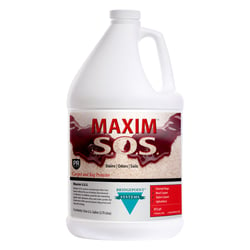 Bridgepoint Systems, Carpet Protector, Maxim S.O.S. Stain, Odor, & Soil, 1 Gallon
Bridgepoint Systems, Carpet Protector, Maxim S.O.S. Stain, Odor, & Soil, 1 Gallon
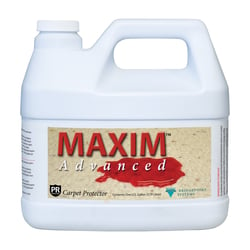
Bridgepoint Systems, Carpet Protector, Maxim Advanced, 1 Gallon

Bridgepoint Systems, Upholstery Cleaning, Maxim Fine Fabric Solvent Protector, 1 Gallon
Enjoyed reading this post? Read the following articles:

